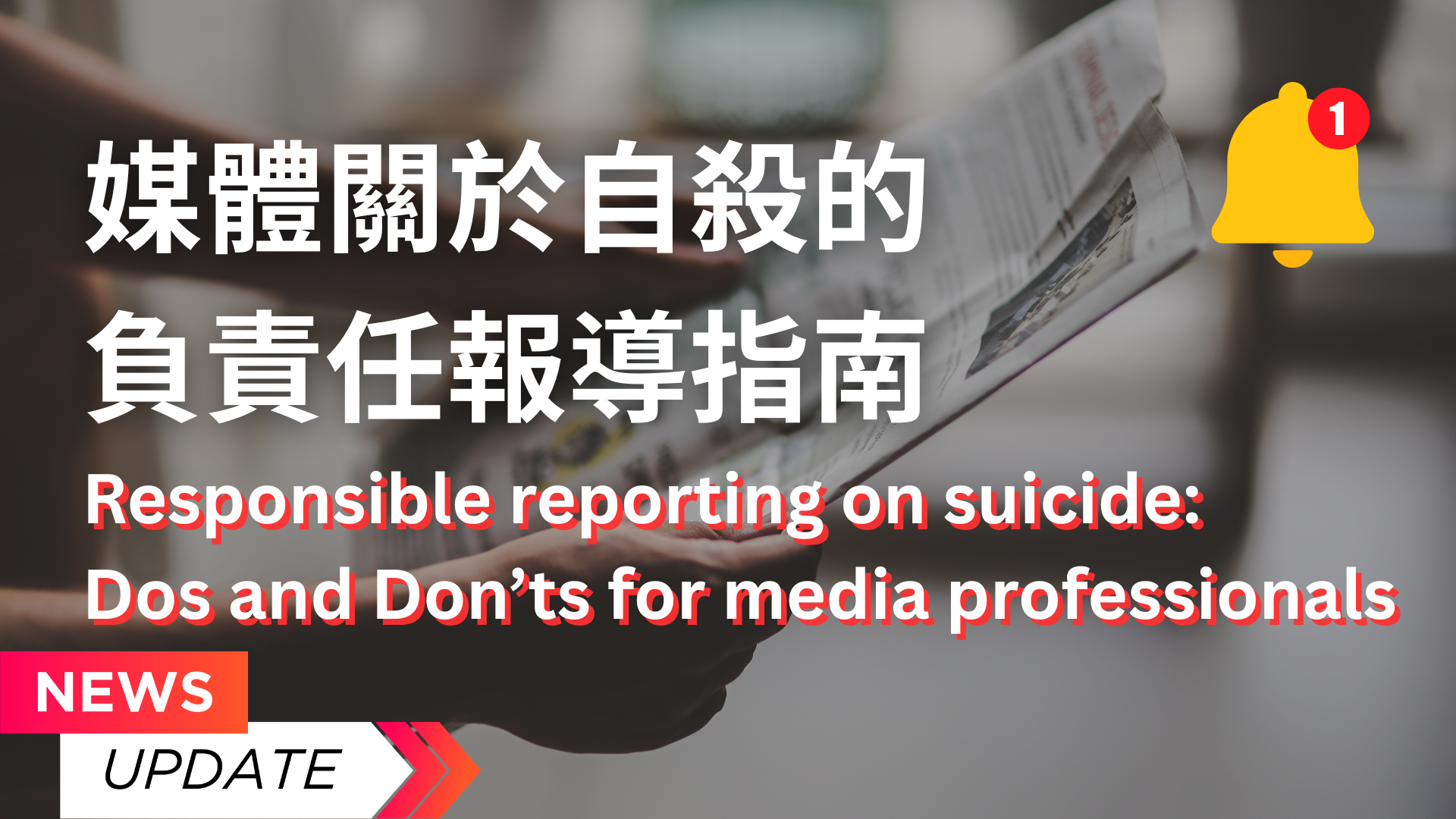
鑑於有研究顯示,傳媒對自殺事件的報導方式可能對自殺預防工作產生截然不同的影響。因此,世界衛生組織2023年更新了自殺新聞報導發布指南,建議傳媒工作者在報導相關議題時,嚴格遵守本指南所列出的報導原則與注意事項。本中心整理了指南的一些報導自殺新聞的要點,協助傳統與網路媒體從業員以恰當方式報導與自殺相關的新聞。
As evidence suggests, widespread reports of suicide deaths frequently correlate with a rise in suicides, whereas narratives highlighting individuals who successfully navigate suicidal crises can contribute to a reduction in suicide rates. In response to this, the World Health Organization (WHO) has revised its guidelines to encourage media professionals to prioritize the portrayal of stories featuring individuals who overcome challenges following a suicidal crisis, while also adhering to the guidelines specified in this resource when reporting on suicide. Our Centre has condensed the essential elements from the manual to assist media professionals in appropriately representing news or information concerning suicides, utilizing both traditional and digital media.
✓ 應做的事
提供求助資訊
- 與自殺相關的新聞報導,在開頭或結尾都應附帶有預防自殺服務、危機熱線和社區資源的詳細資訊。
- Include information about support services like suicide prevention centres and crisis lines at the end or beginning of suicide-related stories.
- 應定期檢查所提供的危機支援服務的準確性。
- Regularly check contact details for accuracy.
- 應只提供最基本的危機支援服務資訊,太多的選擇只會使已經受困擾的人士更混亂。
- Limit the number of services mentioned to avoid overwhelming the audience.
公眾教育
- 分享有關自殺的準確資訊,強調預防自殺的重要性,並鼓勵求助行為。
- Address myths/misconceptions about suicide. Focus on facts about suicide prevention and encourage help-seeking behaviours.
- 為了確保傳廣的信息準確無誤,應先向專業或相關人士查詢,並避免傳播及助長迷思,引致模仿行為。
- Consult suicide prevention experts for accurate information.
強調求助的必要
- 應報導與克服逆境和積極面對生命的故事,並鼓勵求助行為。
- Share personal narratives of those who have overcome suicidal thoughts.
- 在新聞報導中融入心理教育,縱然在面對極大困擾時仍可找到相關的協助。
- Integrate educational materials on finding help during difficult times.
- 報導有關市民的善舉,主動幫助他人預防自殺的實例,闡明每個人都能為預防自殺出一分力。
- Highlight examples of people supporting others in crisis.
- 加入網站連結,讓有需要的人士更容易接駁到預防自殺的機構、危機熱線和其他支援構構。
- Provide links to suicide prevention organizations.
小心處理名人自殺報導
- 在報導名人自殺新聞時,應專注逝者生前的生活及對社會的貢獻。亦應提及自殺所帶來的負面影響,避免報導自殺的細節或簡化導致自殺的原因。
- When reporting on celebrity suicides, emphasise the individual's contributions to society and the adverse effects of their death on others, rather than detailing the suicidal act or providing simplistic explanations for the suicide.
- 報導不應描述自殺方法或地點,更不應試圖以任何方式美化自殺行為。
- Reports should not describe the suicide method or location, and should not glamorize the suicide in any way.
- 在其死因未確定前,不宜猜度死因。
- Wait for confirmed causes of death before reporting.
謹慎地處理喪親者訪談
- 當訪問遺屬時,應避免令他們帶來二次傷害。
- Be sensitive when conducting interviews because bereaved individuals may be at risk of retraumatization.
- 盡一切可能避免採訪喪親的孩童。
- Avoid interviewing children who have lost a parent to suicide.
- 採訪者應給予遺屬時間和空間去消化親友已經自殺身亡的事實,在此之前不應採訪遺屬。
- Protect the privacy of interviewees and provide support during interviews.
- 喪親者所面對的哀痛難以言喻,應理解其情緒狀態可能會影響所提供資訊的準確性。
- Be careful with the accuracy of information provided by bereaved individuals.
- 應事先讓受訪者知悉,採訪有可能帶來的潛在風險,並應採取措施盡可能保護他們的私隱,以及在發布前應再次通知受訪者有關報導,以便進行修改或更正。
- Ensure the interviewee's privacy by discussing the interview process and potential risks with them beforehand. Interviewees should review their personal accounts in reports before publication to make any necessary corrections.
關注新聞工作人員的精神健康
- 在處理自殺報導時,傳媒人士的情緒也可能受到影響。
- Recognize that covering suicide stories can emotionally impact media professionals.
- 傳媒機構應為報導自殺新聞的工作人員提供支援和培訓,以保障他們的福祉。
- Offer necessary support, such as debriefing opportunities and regular training on responsible reporting.
- 如果個別傳媒人士情緒受到任何負面影響,應鼓勵他們向相關服務機構尋求幫助。
- Encourage media professionals to seek help if needed.
✕ 不應做的事
避免顯眼及重複的報導
- 不要將自殺新聞作為頭條報導,以防引發模仿行為。
- Do not position suicide stories as top news or repeat them unnecessarily. Place stories on inside pages rather than front pages.
- 線上新聞媒體不應為關於特定自殺的故事啟用公眾「評論」功能。如果平台設有評論功能,則應有一個系統來監控和管理與自殺報導相關的在線評論。
- Limit public comments on suicide-related stories to prevent harmful discussions.
不宜描述自殺方法及地點
- 避免詳細說明自殺的方式及地點,以免激發模仿行為。
- Avoid discussing specific methods, images, or details of suicide.
- 需要謹慎報導罕見或不尋常的自殺方法。
- Do not mention specific locations where suicides have occurred. Avoid promoting locations that may become known as "suicide sites."
避免使用煽情字眼
- 避免使用正常化或美化自殺的語言;應低調報導事實。
- Refrain from sensationalizing or romanticizing suicide.
- 使用中性的語言,避免使用暗示犯罪或美化自殺的字眼。
- Use factual language that frames suicide as a public health issue. Avoid terms that imply criminality or glorify the act.
不宜簡化自殺原因
- 避免將自殺歸因於單一因素;自殺從來並非單一原因造成。
- Acknowledge the complexity of factors leading to suicide. Avoid linking suicide to a single cause.
避免使用煽動性標題
- 標題應使用謹慎及中性的詞語,應避免使用嘩眾取寵的字眼,亦避免用「自殺」來吸引眼球,除非文章是對公眾教育與預防自殺相關。
- Headlines should avoid including references to methods or locations. Collaborate with headline writers to ensure appropriate language.
不宜使用照片、影片片段、錄音或社交媒體連結
- 不宜提供有關自殺地點、位置的詳細資料及圖像。
- Do not use photographs or recordings from suicide scenes.
- 不應公開逝者的容貌和身軀,如果有必要公開其樣貌,必須獲得遺屬的同意。
- Obtain permission for images of individuals who are not widely known.
不宜公開自殺者的遺書或最後訊息
- 不應報導或播出自殺者的遺書或個人訊息,以保護逝者的尊嚴,以及其家屬的私隱。
- Avoid publishing details of suicide notes or last messages.
References: World Health Organization. (n.d.). Preventing suicide: A resource for Media Professionals, update 2023. World Health Organization. https://www.who.int/publications/i/item/9789240076846